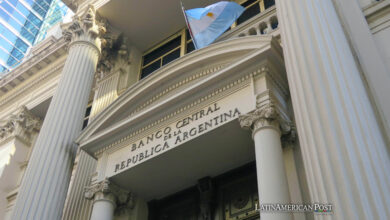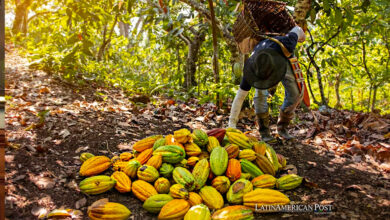The Colombian Panela Industry Is in Crisis. Will It Survive?
Panela has been considered an icon in Colombian gastronomy for several decades. However, it is not exempt from crises that put the future of the product at risk .

Photo: Ezhuttukari
LatinAmerican Post | David García Pedraza
Listen to this article
Leer en español: La industria de la panela colombiana está en crisis ¿Sobrevivirá?
Coffee, sugar, arepas and panela cannot be missing from the kitchens of Colombian families. They are ingredients that have been immersed in the food culture of the South American country for many years and that have seen the passing of many generations. Panela is a solid sugar made of sugarcane juice.
Lately, as happened with pork, potatoes and tea, panela has had an advertising boom in Colombia, in the seven months leading up to 2022. It could be said that it is a product that is at its best point of production and marketing. However, for the panela's sector it is not like that. Dignidad Panelera, an association headed by Denis Ariza, reported that artificial products – panela – made by large food companies are displacing the consumption of traditional panela by 60%, which translates into great losses for farmers, who work sugar cane every day and have their businesses in rural areas of Colombia.
This crisis in the sector has reaffirmed a panelero strike that is taking place in the month of July and with which the paneleros hope that forceful actions will be taken so that the traditional product, and the families that depend on it, are not affected more than the ones they have today. In addition, they hope that with the new government, which will be installed in less than a month, the product of the peasants will be supported more than that of the large soft drink companies.
The Panela in the Daily Life of Colombians
Whether served in cubes, mixed with water, as a sweetener (replacing sugar) or in a bar, similar to chocolate bars, panela is a versatile and affordable food in the daily life of Colombian society. It is used to make home remedies to treat colds, as an exfoliant to keep the skin hydrated, as an ingredient for making desserts, as a sweetener for lemonade and even to take as a souvenir to foreign homes. This sweet tradition has marked a legacy in the gastronomy of the country, even having a festival in the municipality of Villeta, Cundinamarca, in the center of the country, located two hours from Bogotá, and a beauty pageant in which the National Queen of Panela is chosen, in order to have an ambassador to advertise this national product.
Despite the fact that panela is food that contains a sentimental character in Colombians, and has a considerable consumption of 19.5 kilos per capita in the country, based on the most recent figures dating from 2021 according to Fedepanela, it competes a lot with another products like coffee and chocolate. According to the Federation of Coffee Growers by the end of 2020, Colombians consumed more than 21 million cups of coffee per day, and according to the National Federation of Chocolates, 12 million cups of chocolate in the same period. This scenario is due to the fact that panela is seen as an addition to breakfast, lunch and dinner, but not as a main companion, as happens with chocolate and coffee.
You may also be interested in:What Do Businessmen Think of Gustavo Petro and His Next Government in Colombia?
A Debt With the Panela's Sector Since Before the Pandemic
Although this sector had an upward stability in 2018 and 2019, according to Fedepanela, the COVID-19 pandemic left several unknowns about the marketing of panela in the sugar cane peasantry. Despite the fact that the demand for the product has increased in Colombian homes, the panela's producers are unemployed. They do not accept the opportunities that the federation grants to large companies for the manufacture and commercialization of artificial panela beverages, while the primary and traditional sector loses day by day their crops and work.
An example of the crisis in the sector was the 50% rise in the price of panela in 2020, due to the fact that in January of that year the price of this product was $3,521, while in November 2019 it was $2,427, according to Carlos Mayorga, former general manager of Fedepanela. Despite the fact that more Colombians consumed panela, thanks to the markets distributed by the government to meet the food needs of those affected by the quarantines, the cost was higher than when there was no health emergency.
Added to this problem is the smuggling of panela, a nuisance that has been denounced from the Federation itself where it is expressed on the borders with Ecuador and Venezuela there are people who melt sugar and sell the product as if it were panela, deceiving the consumer and losing loyalty in this national food. Again, the high command, such as Invima, have not paid attention to this practice.
What Would Come for This Product
In 2018, Mayorga said that by 2022 panela exports would go from 4,000 to 18,000 tons, with the United States and Europe being the places where more emphasis would be placed for this product to arrive. It should be noted that in countries such as Brazil, South Korea and Argentina, Colombian panela has been well received. However, there is no current figure that supports or spares Mayorga's expectation of four years ago.
Panela is produced in 29 of the 32 departments that Colombia has, with the interior of the Andean country being the one that produces the most quantity, such as Santander with 17%, Antioquia with 16%, Cundinamarca with 15% and Boyacá with 13. %. This is one more reason to reflect on the potential of this product that has accompanied Colombian society for a long time, and that now, and long before, has been forgotten, both the product and the primary workers in the agriculture sector.





